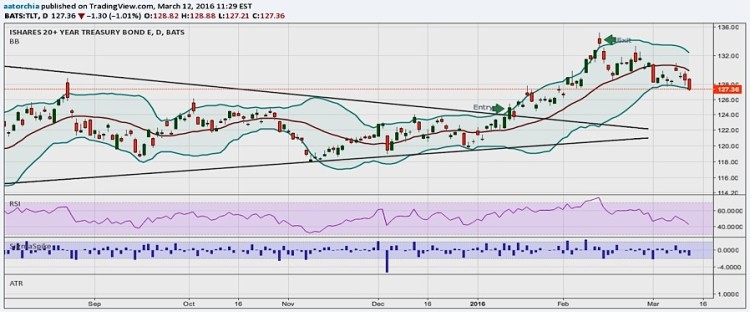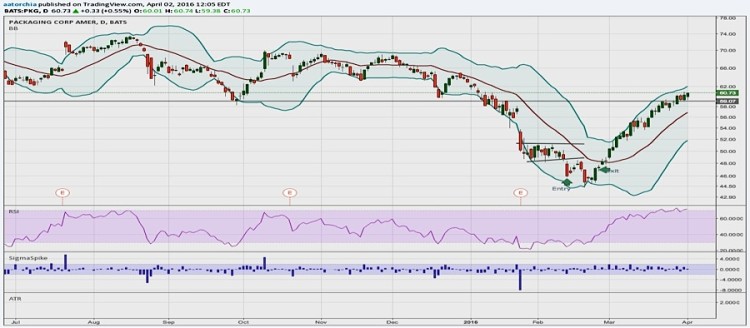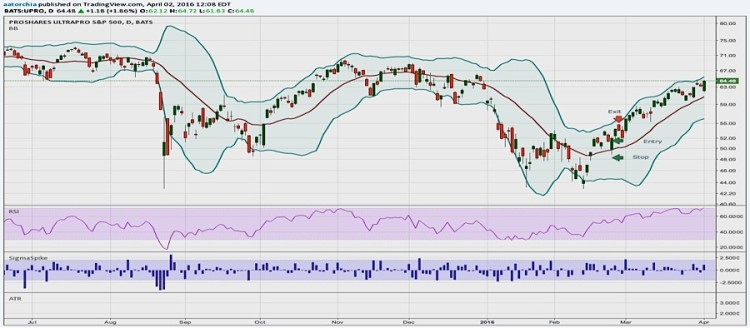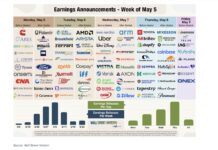I am beginning to publicly report my quarterly performance every 3 months along with a trading review. As well, each quarter I am setting 3 goals to focus for the following period.
My focus points on January 1, 2016 were:
1) Focusing on best entries, waiting until the close to make final decisions.
2) When in chop, sit it out.
3) Fine tuning my trading process and thinking in probabilities.
Here’s a more in-depth look at these goals:
- I try to wait until an hour before the market closes to place any orders. I trade the daily/weekly timeframe, nothing is worse than placing an order during the middle of the day and then having the market close adversely to my position. This rule has kept me out of a lot of losing trades. Some days reversals can happen out of nowhere that can invalidate an entry thesis immediately. I learned from my mistakes and this quarter I only focused on taking entries in the last hour.
- When markets are chopping, it is like death from a thousand cuts. As individual traders, we have an advantage in that we can sit out on the sidelines as long as we want, waiting until the current market conditions favor our trading style again. As a daily timeframe swing trader, I only took 11 entry signals this quarter. That may seem extremely light but I am proud of my discipline to sit out until the market favors my style of trading.
- I think the third point is what can make a good trader a great trader. I focused most of my energy this quarter on creating an extensive relative strength system for filtering market leaders and laggards. Instead of picking random securities to buy and sell, I created a rigid screening system, for me it felt as if became more professional. Also, I have begun to really dig deeper into getting away from the “money” aspect of trading. I only care about my %R now; the actual dollar gain/loss means nothing to me anymore. I truly respect the randomness of the market place and I think that is what separates myself from other traders. All I know is that when I enter a trade, I have a mere 60% advantage of a profitable trade. My last trade being a winner or a loser has no affect on the outcome of the next trade. I write a lot about these topics in previous blog posts if you are interested in digging deeper read the following links:
You Want To Be A Winner? Follow Your Trading Process
Profitable Trading Starts With Riding The Bus
It is obvious that to progress as a trader you have to make mistakes and learn from them. To loosely quote Assad Tannous, “If you make enough mistakes trading you will eventually run out of mistakes to make”. That is my goal with these quarterly focus points; I am hoping that one day I will run out of focus points. However, as I am still young, I have many more focus points to craft. Here are my three for the next quarter:
1) Using wider stops to avoid the noise of getting ticked out of what would have been a profitable trade.
2) Improving my trading journal and performance tracking.
3) Making my trading even simpler with this mantra. “I have a pattern (buying pullbacks in markets with an imbalance). With this pattern I have a 60% probability of hitting my target. The distribution of my wins and losses is completely random. Nothing more, nothing less.”
Now to my actual quarter’s performance, I mentioned earlier that I evaluate my trading performance based off of %R. This quarter I registered a 2R profit. This may not sound like a lot but it was a tough trading environment. I tried to remain patient, follow my rules and wait for the best entries. Knowing when to stay out is or maybe even more important than knowing when to get in. I am proud of the way I handled this quarter. When the “easy money” comes around again I will be ready to strike.
I have one other important trading performance metric for this quarter. I had a 41.67% win rate. But I hit 57.55% of my initial profit targets without moving my initial stop/profit target. Which is pretty close to my 60% expected edge. I am happy that my realized edge is close to my potential edge.
Now to some actual trades. I do not care so much for my actual trades because the outcome of the trades is completely random. I do not believe in making “great calls” or any of that garbage. However, I will present what I would consider my “best” and “worst” trades. To be clear, I do not care about a “profitable” or an “unprofitable” trade. A profitable trade could be a bad thing if rules were broken or if the trading process was not adhered to. But I digress; here are some trades I thought were my highpoints and low points. I hope you can add some value to your trading by learning from my mistakes. If you have any questions or comments feel free to reach out to me.
I went long TLT after a massive breakout. I exited the trade upon a hint of trend exhaustion, which proved to be the end of the up thrust. The lesson here is to avoid being on the wrong side of a climaxing trend. (Depending on trading style/methodology) I exited the trade for a solid 1.7x %R gain.
I went short PKG on a simple bear flag breakdown. The trade worked for a couple days but I began to see strong adverse price action to my entry. I decided to exit the trade for .1x %R loss, almost a breakeven trade. The important lesson here is knowing when a thesis is invalidated. With the adverse price action, I accepted my loss and moved on. Someone who was stubborn or did not trade with stops may have remained in the trade. As you can tell, after my exit it was not fun to be a short anymore.
My most unfavorable trade was going long SPY via UPRO, even though I exited the trade for a .3x %R gain. I felt uncomfortable sitting in the trade for some reason and I decided to exit. As a discretionary trader I sometimes let my intuition creep into my trading, it is what separates me from an algorithmic trading system. Unfortunately for me, if I sat in the trade it would probably have been my trade of the year. It currently would be a near 3x %R gain. But the lesson is to have a short memory and move on. The past is the past and more opportunities will present themselves in the future.
Thanks for reading.
Twitter: @Johnny_Manzz
Any opinions expressed herein are solely those of the author, and do not in any way represent the views or opinions of any other person or entity.











